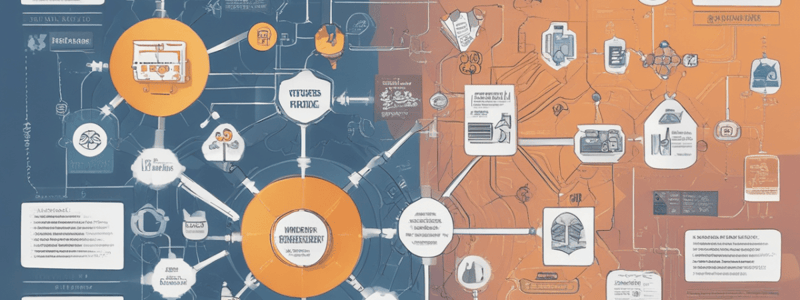Podcast
Questions and Answers
What is the purpose of a flow chart in a maintenance process?
What is the purpose of a flow chart in a maintenance process?
- To replace wheel bearings
- To guide maintenance personnel through a fault finding process (correct)
- To check torque for each wheel
- To adjust brake control valve
In a flow chart, what type of box represents a decision point?
In a flow chart, what type of box represents a decision point?
- A triangle
- A diamond (correct)
- A rectangle
- An oval
Which step should be taken if the brake running clearance is not satisfactory?
Which step should be taken if the brake running clearance is not satisfactory?
- Re-rig the system
- Adjust the brake control valve
- Replace the wheel bearings
- Check for damaged rotors (correct)
What do boxes in a flow chart represent?
What do boxes in a flow chart represent?
If the leak in a valve is not within limits after 12 cycles, what should be done according to the text?
If the leak in a valve is not within limits after 12 cycles, what should be done according to the text?
Which symbol is typically used to represent a processing step in a flow chart?
Which symbol is typically used to represent a processing step in a flow chart?
What does a flow chart typically include to signal the start and end of a process?
What does a flow chart typically include to signal the start and end of a process?
In a fault isolation process, what symptom does the flow chart in the text begin with?
In a fault isolation process, what symptom does the flow chart in the text begin with?
When tasked with rectifying faults, what is highly encouraged for technicians according to the text?
When tasked with rectifying faults, what is highly encouraged for technicians according to the text?
What technique is mentioned in the text as useful for generating many ideas quickly to improve a process or solve a problem?
What technique is mentioned in the text as useful for generating many ideas quickly to improve a process or solve a problem?
What type of faults may be suitable for brainstorming when all other options are exhausted?
What type of faults may be suitable for brainstorming when all other options are exhausted?
What is essential for everyone to do during brainstorming sessions as mentioned in the text?
What is essential for everyone to do during brainstorming sessions as mentioned in the text?
What is the purpose of the half-split rule in fault localization?
What is the purpose of the half-split rule in fault localization?
In the fault isolation process using the half-split rule, what should be done if one half does not identify the fault?
In the fault isolation process using the half-split rule, what should be done if one half does not identify the fault?
Which component should be assumed as faulty if there is no output at point 2 in the linear system shown in this figure?
Which component should be assumed as faulty if there is no output at point 2 in the linear system shown in this figure?
What should be done next if there is no output at point 1 after checking at point 2 in the linear system?
What should be done next if there is no output at point 1 after checking at point 2 in the linear system?
In the half-split fault finding process, what is done after identifying a faulty half?
In the half-split fault finding process, what is done after identifying a faulty half?
What step is taken in the fault localization process if there is an output at point 1 after checking at point 2 in the linear system?
What step is taken in the fault localization process if there is an output at point 1 after checking at point 2 in the linear system?
Flashcards are hidden until you start studying
Study Notes
Flow Charts
- A flow chart is a schematic representation of a process, using boxes to represent steps and their order with arrows.
- It guides maintenance personnel through a fault finding process using standard symbols.
- A simple flow chart includes symbols to signal the start and end of the process.
- The flow chart commences with the symptom of the fault and ends with an activity to repair.
Corporate Knowledge
- An organisation builds up a repository of knowledge acquired over a long period of time.
- Difficult faults are remembered, and when rectified, the process of solving the problem is rarely forgotten.
- Seeking assistance from senior trade personnel, supervisors, and Subject Matter Experts (SMEs) is highly encouraged when tasked with rectifying faults.
Brainstorming
- Brainstorming is a widely used technique for a small group to generate many ideas in a short time, often to improve a process or solve a problem.
- It is often more effective than individuals working alone in generating ideas to isolate a difficult fault.
- Brainstorming requires that everyone must contribute.
Fault Localisation
- The ‘half-split rule’ is an effective way to find faults by simplifying systems into a flow diagram or path.
- The flow can be either mechanical or electrical.
- The half-split fault finding process involves:
- Checking the complete system.
- Splitting the system into two halves.
- Checking each half individually.
- Further splitting the faulty half until the fault is isolated.
Studying That Suits You
Use AI to generate personalized quizzes and flashcards to suit your learning preferences.




